By Nuria Estrella Santos
Puerto Lopez and the Transit of the Whales
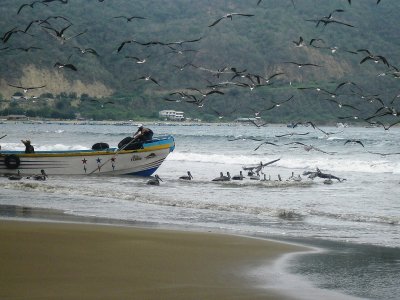 Every year the arrival of the humpback whales changes the lives of Puerto Lopez, a fishing village in the south central coast of Ecuador. The whales migrate from the polar regions to warm equatorial Pacific waters for mating and reproduction. Puerto Lopez, has an urban population of 8,000 inhabitants and is situated within the Machalilla National Park. It is mainly a fishing village, which for nearly two decades has developed a growing tourist activity around whale watching and visits of the Machalilla National Park (Photos Nuria Estrella Santos unless indicated otherwise).
Every year the arrival of the humpback whales changes the lives of Puerto Lopez, a fishing village in the south central coast of Ecuador. The whales migrate from the polar regions to warm equatorial Pacific waters for mating and reproduction. Puerto Lopez, has an urban population of 8,000 inhabitants and is situated within the Machalilla National Park. It is mainly a fishing village, which for nearly two decades has developed a growing tourist activity around whale watching and visits of the Machalilla National Park (Photos Nuria Estrella Santos unless indicated otherwise).
In this context, the role of tourism as one of the main factors for the development of Puerto Lopez, it is undeniable, but tourism brings some perverse effects: urban congestion, social changes, the accumulation of all types of waste, damage to ecosystems and biodiversity.
Until now, the tourist activity in Puerto Lopez contributes little to conservation. In a regular operation, for example, where a tourist boat gives one or two snacks to between 16-20 tourists on board the whale watching tours or to Silver Island (Isla de la Plata), are generating at least 30 disposable plastic cups daily. The tourist season lasts about 4 months and there are at least 20 registered vessels engaged in whale watching tours and tours to the Isla de la Plata, even apart from other boats that carry out tours illegally.

To make a conservative estimate, assume that during the four months of high season from June to September, 20 ships make an average of 7 trips per month each. This translates into nearly 20,000 disposable plastic cups. The picture is not complete without the soft drink bottles that are at least 2 per transaction ... Thus, considering that 12 tons of garbage are produced daily in the canton of Puerto Lopez, in the peak tourist season this increases by between 2 and 4 tons of waste, mainly plastics.
While waste is a worldwide problem, in developing countries like Ecuador, this is heightened even more, by population growth, lack of waste treatment, lack of resources, poverty, poor health, increased consumption, lack of management as well as institutional weaknesses, among others. The case of Puerto Lopez confirms this fact. There is very little awareness among the population and the small scale and industrial fisheries about pouring waste into the sea. Indeed, the population has turned some rivers and empty space into landfills, etc.
In a natural protected space, such as the Manchalilla National Park, the sum of these unsustainable practices could jeopardize the conservation of the environment and alter the ecology of the area's flagship species such as whales, turtles and birds.
What is not in the garbage bin ...
The Municipality of Puerto Lopez collects approximately 70% of the waste generated in the county so far without treatment and heaps it up at the disposal site. The system has its weaknesses due to a lack of resources and management. The waste management is currently subsidized by 86%.
The garbage, which is not collected or which people have inappropriately thrown away, accumulates in rivers, streams, and vacant lots. Sooner or later part of this debris reaches the sea, carried by rivers, rain or wind. The artisanal & industrial fishing sectors' waste is often discharged directly into the sea. This is compounded by the garbage which accumulates on the beaches from tourism and unloading activities of the fisheries.
Waste not only creates health risks for people, but also for the lives of marine animals, mainly turtles and sea birds which die from accidental ingestion of residual waste, mainly plastics and discharged netting materials.
The trash on the beaches, which is brought up by the tide and the wind directly, is also a problem. It is an aesthetic problem that gives a bad image to people and therefore affects tourism; but it is also a risk to the public and the visitors, who can suffer accidents by the remains of cans or glass, and constitutes a danger for children playing with garbage on the beach.
What is in our hands.
Faced with this problem and the necessity to act, the project "Support to the Integrated Waste Management in Puerto Lopez, Jama and San Vicente" was set up. The project is funded by the European Union and implemented by the Foundation Santiago of Guayaquil. One of its priority objectives is to influence the population toward more responsible behaviour in managing waste.
In the design of strategies to involve people the RecicleARTE competition was devised to coincide with the whale watching season. The competition aimed at generating awareness among the public about the problems of garbage and spreading the habit of recycling. The idea was to build sculptures of whales, the iconic species of Puerto Lopez, made from recycled material.
Mergers between science and art are not altogether new, but the focus in each case is different, the ultimate goal is to find a new means of expression and a way to sensitize people on environmental issues.
Competition - RecicleARTE
The RecicleARTE contest took place at the end of August 2010 in Puerto Lopez to coincide with the whale watching season. For the competition, the project initially had funding for only one prize winner, however, in the process more participants were becoming involved, mainly children and youth groups. Thus, creating a youth category in the competition would allow to recognize as well the creativity of children. For this, we requested a contribution from the Mundus maris Initiative.
We could get some funding from Mundus maris for children who were involved. This way also they were able to get recognition for their active involvement. The prize for both categories, it was a contribution to any activities that promote the development of the participants.
The contest was oriented primarily towards groups of artisans and recyclers, but individual artists could also participate. There were two categories: artisans and youth. Click here for the conditions of the competition (in Spanish).
Category Craftsmen
Salangome Artisan Group. This is a group of 14 artisans who make handicrafts from various materials; the group includes people living within the Machalilla National Park area and craftsmen living in Puerto Lopez.
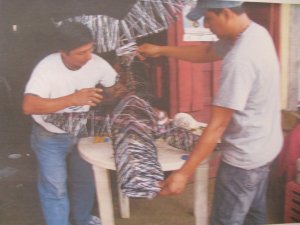 |
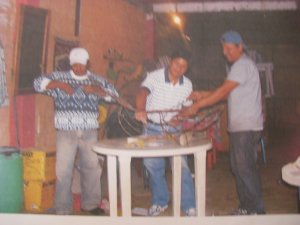 |
 |

The Group created a whale by recycling metal cans, nylon thread from fishing activities, bottle caps and other materials (Photos above: Asociación Salangome).
Alfredo Rocha, Recycler. Alfredo Rocha is dedicated to recycling as a way of life. His home, boat-shaped, is constructed almost entirely of recycled materials. He and his wife are recyclers, who recover any material in the landfill in Puerto Lopez.
 |

|
The sculpture of Alfred was a whale built with a new material created by himself on the basis of flex foam. The following materials were also (re)used in this sculpture: plastic bottles, wire, a float of a fishing net, balls from deodorant bottles to create the eyes of the whale. The base of a fan served to support the sculpture.
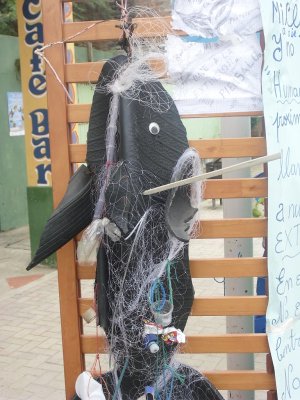 Whale Sanctuary Association (Asociación Santuario de Ballenas).
Whale Sanctuary Association (Asociación Santuario de Ballenas).
This is a tourism association. One of its members, Remigio Fuentes, created a sculpture of a whale made from a tire found on the beach. Remigio's representation was a whale tangled in nets and debris, and the cries of whales for their survival.
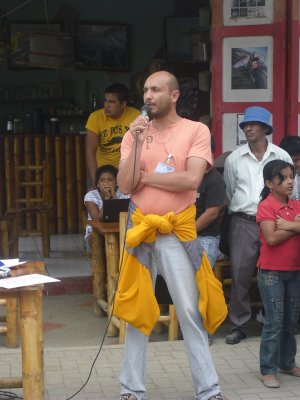
Photos Nuria Estrella Santos |
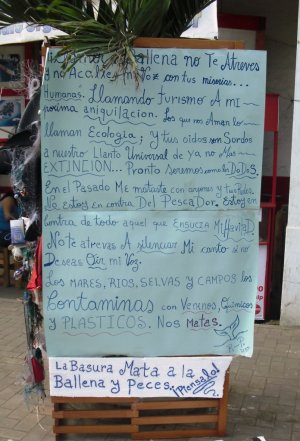 |
Youth Category
Jaime Roldos School and the Nature and Art Foundation. The Jaime Roldos School is a school located in the Barrio San Pedro, the neighborhood where most of the fishers of Puerto López live. The school has 120 children in the different courses. The sculpture of the school was supported by the Nature and Art Foundation, by Laura Hester and an English artist, Lu Johnson. The process of creating the sculpture of a whale was a mixture of a fun exercise, education and conservation. Each class of the school participated in sculpture. The work was divided up organisationally as follows: first picking up trash from the beach, then preparing the materials and ultimately helping to create the sculpture. In the whale tail sculpture lots of waste was used, such as plastic bottles, caps, nets, and wheels. All the garbage was collected on the beach (Photos courtesy Laura Hester).
 |
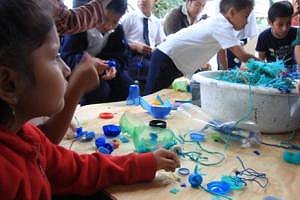 |
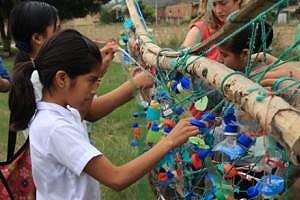 |
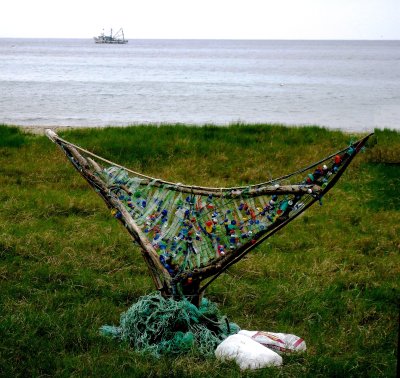
The first mounting of the whale fluke on the greens overseeing the sea was quite evocative.
Ecoclub of Children Guardians of Nature (Ecoclub de Niños Cuidadores de la Naturaleza). The Ecoclub is a local initiative supported by a group of young biologists and ecologists, which aims to promote conservation and education, mainly of marine life. The Ecoclub attracts children with an interest in learning about and caring for nature. Its activities are regularly attended by about 12 to 14 children aged between 7 and 14 years. These children, like the pupils of the Jaime Roldos School, are mainly children of local fishermen. This activity was supported by Micaela Peña and Gabriela Anhalzer.
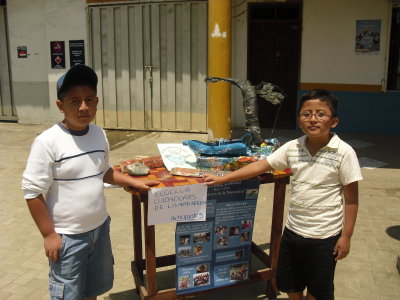 |
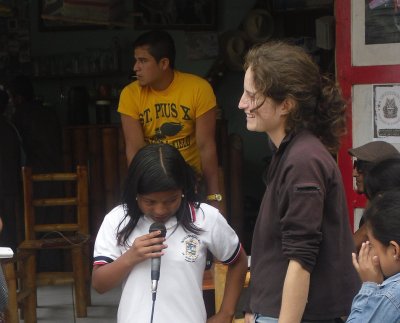 |
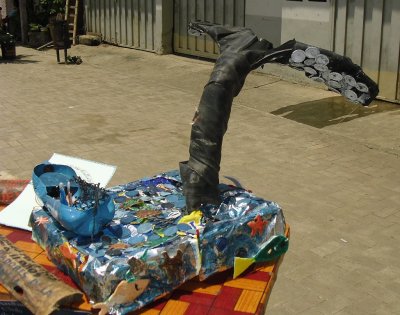 The children collected the rubbish from the beach and created a sculpture in the shape of a whale tail using flat rubber.
The children collected the rubbish from the beach and created a sculpture in the shape of a whale tail using flat rubber.
The whale is sinking in a sea painted with traces of plastic wrap.
Bottle caps and foam flex were also used.
"The Sea asks for your help"
All works were presented during the last week of August 2010 in the central square of Puerto Lopez. The display was completed with posters and information materials on environmental issues and promoted a culture of responsible management of solid waste.
The exhibition was visited by local people and foreign tourists, college groups and schools of Puerto Lopez.
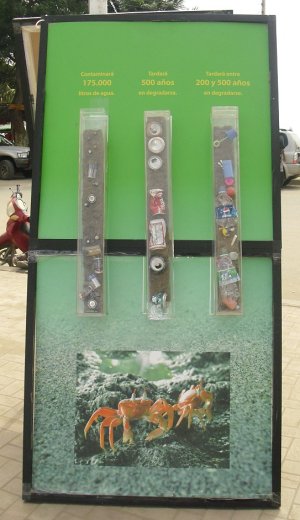 |
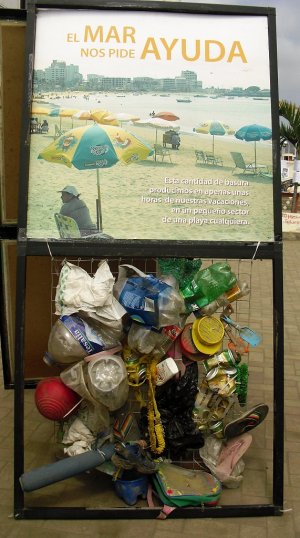 |
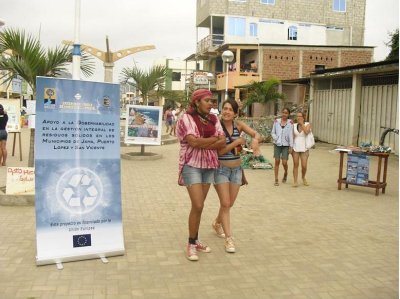 |
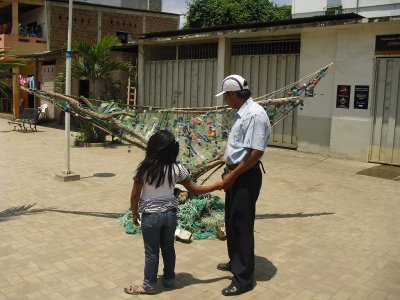 |
The winners
On 2 September 2010 the award of the winners took place. It was nice to see that each job in its own way was different, each had been created based on different materials and with different proposals, which greatly enriched the exhibition.

For the category Artisans the first prize was given to the Association Salangome. The whale created the highest approval rating by the judges and visitors.
Thanks to the support of Mundus maris both participants could be rewarded in the Youth category.
The first prize was won by the Jaime Roldos School and the Nature and Art Foundation. The second prize was awarded to the Ecoclub of Children Guardians of Nature. The two awards were in cash in order to address a need and enable some activity of the winners.

The Jaime Roldos School used the $150 prize for improving school infrastructure, which is very poor. It does not have doors to the classrooms. With the help of Laura Hester of the Nature and Art Foundation are now making improvements in the school. Read more about this experience soon.
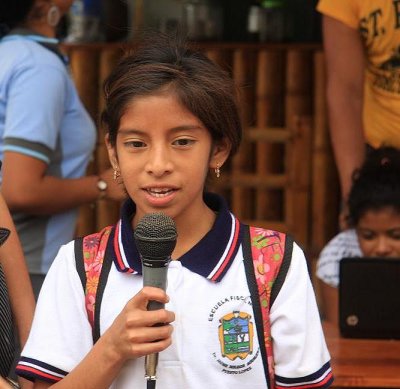
The prize for the Ecoclub, $100, was used so that the 12 children would get to know the Isla de la Plata. The children had never seen the island that is part of the Machalilla National Park. They could rent snorkel masks and visit the island along with their guides Gabriela Anhalzer and Micaela Peña. The Machalilla National Park collaborated by providing the craft for transfer to the island. Read more from Laura Hester about this experience and what is planned as a follow-up.
About the author:
Nuria Estrella Santos holds a MSc. degree in environmental engineering of the Free University of Brussels and is a former intern of the International Science and Technology Cooperation (INCO) Programme at the European Commission in Brussels. She now works for the Fundación Santiago de Guyaquil in the waste management project in Puerto Lopez, Jama and San Vicente on the Ecuadorian coast, financed by the European Union.
There are other initiatives in the region, intent on nature protection and more sustainable fisheries. Click here for one of several examples.
By Nuria Estrella Santos
Puerto Lopez and the Transit of the Whales
 Every year the arrival of the humpback whales changes the lives of Puerto Lopez, a fishing village in the south central coast of Ecuador. The whales migrate from the polar regions to warm equatorial Pacific waters for mating and reproduction. Puerto Lopez, has an urban population of 8,000 inhabitants and is situated within the Machalilla National Park. It is mainly a fishing village, which for nearly two decades has developed a growing tourist activity around whale watching and visits of the Machalilla National Park (Photos Nuria Estrella Santos unless indicated otherwise).
Every year the arrival of the humpback whales changes the lives of Puerto Lopez, a fishing village in the south central coast of Ecuador. The whales migrate from the polar regions to warm equatorial Pacific waters for mating and reproduction. Puerto Lopez, has an urban population of 8,000 inhabitants and is situated within the Machalilla National Park. It is mainly a fishing village, which for nearly two decades has developed a growing tourist activity around whale watching and visits of the Machalilla National Park (Photos Nuria Estrella Santos unless indicated otherwise).
In this context, the role of tourism as one of the main factors for the development of Puerto Lopez, it is undeniable, but tourism brings some perverse effects: urban congestion, social changes, the accumulation of all types of waste, damage to ecosystems and biodiversity.
Until now, the tourist activity in Puerto Lopez contributes little to conservation. In a regular operation, for example, where a tourist boat gives one or two snacks to between 16-20 tourists on board the whale watching tours or to Silver Island (Isla de la Plata), are generating at least 30 disposable plastic cups daily. The tourist season lasts about 4 months and there are at least 20 registered vessels engaged in whale watching tours and tours to the Isla de la Plata, even apart from other boats that carry out tours illegally.

To make a conservative estimate, assume that during the four months of high season from June to September, 20 ships make an average of 7 trips per month each. This translates into nearly 20,000 disposable plastic cups. The picture is not complete without the soft drink bottles that are at least 2 per transaction ... Thus, considering that 12 tons of garbage are produced daily in the canton of Puerto Lopez, in the peak tourist season this increases by between 2 and 4 tons of waste, mainly plastics.
While waste is a worldwide problem, in developing countries like Ecuador, this is heightened even more, by population growth, lack of waste treatment, lack of resources, poverty, poor health, increased consumption, lack of management as well as institutional weaknesses, among others. The case of Puerto Lopez confirms this fact. There is very little awareness among the population and the small scale and industrial fisheries about pouring waste into the sea. Indeed, the population has turned some rivers and empty space into landfills, etc.
In a natural protected space, such as the Manchalilla National Park, the sum of these unsustainable practices could jeopardize the conservation of the environment and alter the ecology of the area's flagship species such as whales, turtles and birds.
What is not in the garbage bin ...
The Municipality of Puerto Lopez collects approximately 70% of the waste generated in the county so far without treatment and heaps it up at the disposal site. The system has its weaknesses due to a lack of resources and management. The waste management is currently subsidized by 86%.
The garbage, which is not collected or which people have inappropriately thrown away, accumulates in rivers, streams, and vacant lots. Sooner or later part of this debris reaches the sea, carried by rivers, rain or wind. The artisanal & industrial fishing sectors' waste is often discharged directly into the sea. This is compounded by the garbage which accumulates on the beaches from tourism and unloading activities of the fisheries.
Waste not only creates health risks for people, but also for the lives of marine animals, mainly turtles and sea birds which die from accidental ingestion of residual waste, mainly plastics and discharged netting materials.
The trash on the beaches, which is brought up by the tide and the wind directly, is also a problem. It is an aesthetic problem that gives a bad image to people and therefore affects tourism; but it is also a risk to the public and the visitors, who can suffer accidents by the remains of cans or glass, and constitutes a danger for children playing with garbage on the beach.
What is in our hands.
Faced with this problem and the necessity to act, the project "Support to the Integrated Waste Management in Puerto Lopez, Jama and San Vicente" was set up. The project is funded by the European Union and implemented by the Foundation Santiago of Guayaquil. One of its priority objectives is to influence the population toward more responsible behaviour in managing waste.
In the design of strategies to involve people the RecicleARTE competition was devised to coincide with the whale watching season. The competition aimed at generating awareness among the public about the problems of garbage and spreading the habit of recycling. The idea was to build sculptures of whales, the iconic species of Puerto Lopez, made from recycled material.
Mergers between science and art are not altogether new, but the focus in each case is different, the ultimate goal is to find a new means of expression and a way to sensitize people on environmental issues.
Competition - RecicleARTE
The RecicleARTE contest took place at the end of August 2010 in Puerto Lopez to coincide with the whale watching season. For the competition, the project initially had funding for only one prize winner, however, in the process more participants were becoming involved, mainly children and youth groups. Thus, creating a youth category in the competition would allow to recognize as well the creativity of children. For this, we requested a contribution from the Mundus maris Initiative.
We could get some funding from Mundus maris for children who were involved. This way also they were able to get recognition for their active involvement. The prize for both categories, it was a contribution to any activities that promote the development of the participants.
The contest was oriented primarily towards groups of artisans and recyclers, but individual artists could also participate. There were two categories: artisans and youth. Click here for the conditions of the competition (in Spanish).
Category Craftsmen
Salangome Artisan Group. This is a group of 14 artisans who make handicrafts from various materials; the group includes people living within the Machalilla National Park area and craftsmen living in Puerto Lopez.
 |
 |
 |

The Group created a whale by recycling metal cans, nylon thread from fishing activities, bottle caps and other materials (Photos above: Asociación Salangome).
Alfredo Rocha, Recycler. Alfredo Rocha is dedicated to recycling as a way of life. His home, boat-shaped, is constructed almost entirely of recycled materials. He and his wife are recyclers, who recover any material in the landfill in Puerto Lopez.
 |

|
The sculpture of Alfred was a whale built with a new material created by himself on the basis of flex foam. The following materials were also (re)used in this sculpture: plastic bottles, wire, a float of a fishing net, balls from deodorant bottles to create the eyes of the whale. The base of a fan served to support the sculpture.
 Whale Sanctuary Association (Asociación Santuario de Ballenas).
Whale Sanctuary Association (Asociación Santuario de Ballenas).
This is a tourism association. One of its members, Remigio Fuentes, created a sculpture of a whale made from a tire found on the beach. Remigio's representation was a whale tangled in nets and debris, and the cries of whales for their survival.

Photos Nuria Estrella Santos |
 |
Youth Category
Jaime Roldos School and the Nature and Art Foundation. The Jaime Roldos School is a school located in the Barrio San Pedro, the neighborhood where most of the fishers of Puerto López live. The school has 120 children in the different courses. The sculpture of the school was supported by the Nature and Art Foundation, by Laura Hester and an English artist, Lu Johnson. The process of creating the sculpture of a whale was a mixture of a fun exercise, education and conservation. Each class of the school participated in sculpture. The work was divided up organisationally as follows: first picking up trash from the beach, then preparing the materials and ultimately helping to create the sculpture. In the whale tail sculpture lots of waste was used, such as plastic bottles, caps, nets, and wheels. All the garbage was collected on the beach (Photos courtesy Laura Hester).
 |
 |
 |

The first mounting of the whale fluke on the greens overseeing the sea was quite evocative.
Ecoclub of Children Guardians of Nature (Ecoclub de Niños Cuidadores de la Naturaleza). The Ecoclub is a local initiative supported by a group of young biologists and ecologists, which aims to promote conservation and education, mainly of marine life. The Ecoclub attracts children with an interest in learning about and caring for nature. Its activities are regularly attended by about 12 to 14 children aged between 7 and 14 years. These children, like the pupils of the Jaime Roldos School, are mainly children of local fishermen. This activity was supported by Micaela Peña and Gabriela Anhalzer.
 |
 |
 The children collected the rubbish from the beach and created a sculpture in the shape of a whale tail using flat rubber.
The children collected the rubbish from the beach and created a sculpture in the shape of a whale tail using flat rubber.
The whale is sinking in a sea painted with traces of plastic wrap.
Bottle caps and foam flex were also used.
"The Sea asks for your help"
All works were presented during the last week of August 2010 in the central square of Puerto Lopez. The display was completed with posters and information materials on environmental issues and promoted a culture of responsible management of solid waste.
The exhibition was visited by local people and foreign tourists, college groups and schools of Puerto Lopez.
 |
 |
 |
 |
The winners
On 2 September 2010 the award of the winners took place. It was nice to see that each job in its own way was different, each had been created based on different materials and with different proposals, which greatly enriched the exhibition.

For the category Artisans the first prize was given to the Association Salangome. The whale created the highest approval rating by the judges and visitors.
Thanks to the support of Mundus maris both participants could be rewarded in the Youth category.
The first prize was won by the Jaime Roldos School and the Nature and Art Foundation. The second prize was awarded to the Ecoclub of Children Guardians of Nature. The two awards were in cash in order to address a need and enable some activity of the winners.

The Jaime Roldos School used the $150 prize for improving school infrastructure, which is very poor. It does not have doors to the classrooms. With the help of Laura Hester of the Nature and Art Foundation are now making improvements in the school. Read more about this experience soon.

The prize for the Ecoclub, $100, was used so that the 12 children would get to know the Isla de la Plata. The children had never seen the island that is part of the Machalilla National Park. They could rent snorkel masks and visit the island along with their guides Gabriela Anhalzer and Micaela Peña. The Machalilla National Park collaborated by providing the craft for transfer to the island. Read more from Laura Hester about this experience and what is planned as a follow-up.
About the author:
Nuria Estrella Santos holds a MSc. degree in environmental engineering of the Free University of Brussels and is a former intern of the International Science and Technology Cooperation (INCO) Programme at the European Commission in Brussels. She now works for the Fundación Santiago de Guyaquil in the waste management project in Puerto Lopez, Jama and San Vicente on the Ecuadorian coast, financed by the European Union.
There are other initiatives in the region, intent on nature protection and more sustainable fisheries. Click here for one of several examples.








